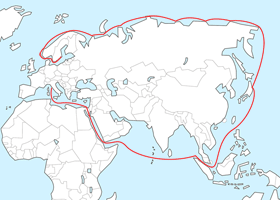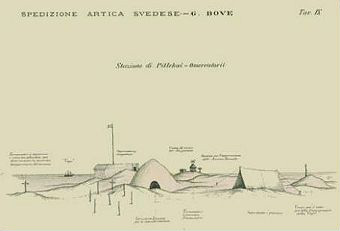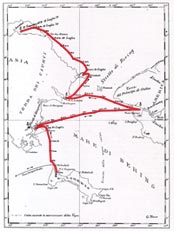|
 From the various attempts to explore the Arctic area, carried out by many people, it was known that the Arctic Basin was bounded on three sides by American and Asian territories. From the various attempts to explore the Arctic area, carried out by many people, it was known that the Arctic Basin was bounded on three sides by American and Asian territories.
Part of the Asian coast was explored, although not completely, by the English, the Swedish and the Russian but the central part were still unexplored.
The Nordenskiold expedition would have been profitable from the scientific and commercial aspects. Giacomo said in a public speech held in Rome on February 10th 1878: “This venture improves the commercial viability by connecting the sea to the railway, utilizing the rivers which run at right angles to the railway. This would improve the whole venture for everybody.”
 
On the 24th September 1877, Giacomo returned from Cape Scaletto (Straits of Messina) to the “Washington” where he was based. Whilst here studying the sea currents, he received the news that he was chosen for the Scandinavian expedition under Nordenskiold. From that moment began for him a period of very hard work. He went to Genoa and Turin to learn all about the region he was going to visit. He also learned French and English and a new language for him, Swedish.
In January he left for Verona via Munich on his way to Stockholm. On the 24th June 1878 the expedition left Carlskome and followed the Norwegian coast northwards. On the 17th July he entered the Arctic Ocean. The ex-whaling ship, originally called “Vega”, was accompanied by smaller steamers “Lena”, “Express” and “Fraser”. In the Kara Sea they had the first encounter with the Samoiedi people.
In August the sea was freezing. While they were exploring the area around the Dixon Islands, G.B. found new islands which were named “Vega”.
Some islands were given Italian names: “Re Umberto”, in honour of the Italian king; “Brin” in honour of the naval minister; “Negri”, in honour of the member of the Italian Geographycal Society, etc. The Cape Correnti was renamed Cape Bove in tribute to its explorer.
They continued on their journey after leaving the ships “Express” and “Fraser” and sailed for the Jenissei river where they found corn.
On August 17th they explored the Taimir strait leaving behind a paper in 3 languages (Swedish, English and Russian) on which was written: “The Swedish artic expedition consisting of 2 ships (“Vega” and “Lena”) left from Dickson harbour on 10 August 1878 it anchored in this bay where it will depart tomorrow towards Celiuskin Cape as soon as the fog clears.
Would you send this letter to H.M. the King of Sweden and Norway.
From Vega on August 17th 1878. (Signed by) A.E. Nordenskiold.”
They went beyond for the first time in the history Celiuskin Cape. The Russian official on that occasion wore full uniform and he toasted the honour of the house in the name of the emperor of Russia.
A polar bear was present also on this occasion.
At the end of Lena river the ship “Lena” left “Vega” and proceeded south. The expedition came across an ice berg and later the sea froze completely. They stopped in the Ciucki territory on the 28th September 1878. They spent the whole winter in Pitlekai until July 1879. They studied the Ciucki people and their civilization, they made hydrographical, meteorological, zoological and botanical observations (G.B. was the hydrographer on board).
They left on the 16th July 1879 and 2 days later they crossed the Bering Strait firing 5 gunshots. They explored Alaska and St. Laurence Island.
On the 2nd of September they arrived at Yokohama where they received tributes. From there they returned across the Indian Ocean and through the Suez Channel they arrived in Naples on the 14th February 1880.
 |
|
|
|




